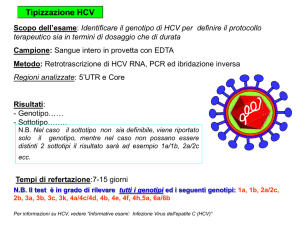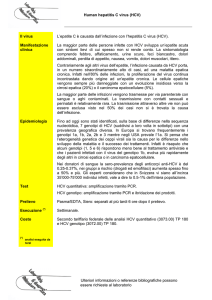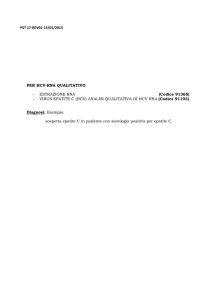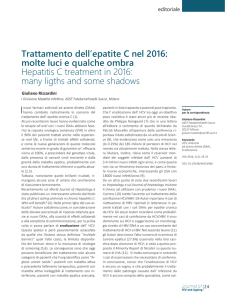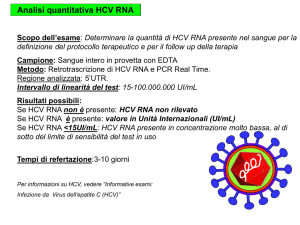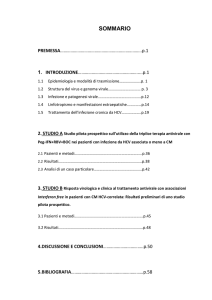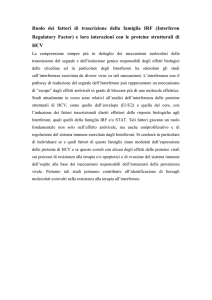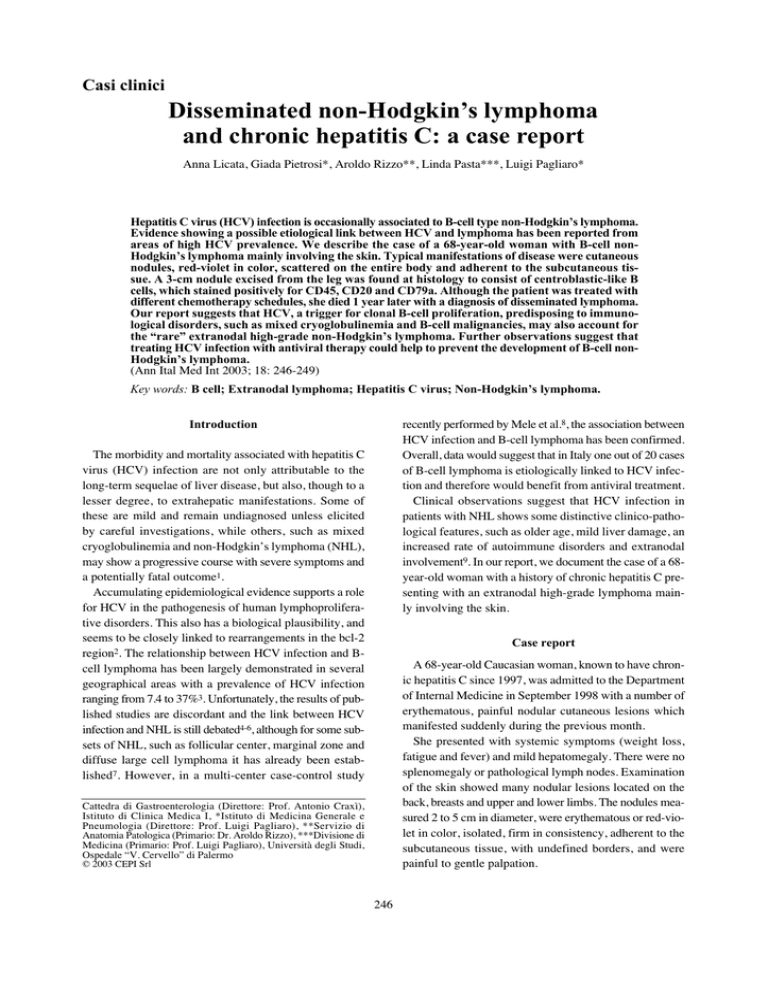
Casi clinici
Disseminated non-Hodgkin’s lymphoma
and chronic hepatitis C: a case report
Anna Licata, Giada Pietrosi*, Aroldo Rizzo**, Linda Pasta***, Luigi Pagliaro*
Hepatitis C virus (HCV) infection is occasionally associated to B-cell type non-Hodgkin’s lymphoma.
Evidence showing a possible etiological link between HCV and lymphoma has been reported from
areas of high HCV prevalence. We describe the case of a 68-year-old woman with B-cell nonHodgkin’s lymphoma mainly involving the skin. Typical manifestations of disease were cutaneous
nodules, red-violet in color, scattered on the entire body and adherent to the subcutaneous tissue. A 3-cm nodule excised from the leg was found at histology to consist of centroblastic-like B
cells, which stained positively for CD45, CD20 and CD79a. Although the patient was treated with
different chemotherapy schedules, she died 1 year later with a diagnosis of disseminated lymphoma.
Our report suggests that HCV, a trigger for clonal B-cell proliferation, predisposing to immunological disorders, such as mixed cryoglobulinemia and B-cell malignancies, may also account for
the “rare” extranodal high-grade non-Hodgkin’s lymphoma. Further observations suggest that
treating HCV infection with antiviral therapy could help to prevent the development of B-cell nonHodgkin’s lymphoma.
(Ann Ital Med Int 2003; 18: 246-249)
Key words: B cell; Extranodal lymphoma; Hepatitis C virus; Non-Hodgkin’s lymphoma.
recently performed by Mele et al.8, the association between
HCV infection and B-cell lymphoma has been confirmed.
Overall, data would suggest that in Italy one out of 20 cases
of B-cell lymphoma is etiologically linked to HCV infection and therefore would benefit from antiviral treatment.
Clinical observations suggest that HCV infection in
patients with NHL shows some distinctive clinico-pathological features, such as older age, mild liver damage, an
increased rate of autoimmune disorders and extranodal
involvement9. In our report, we document the case of a 68year-old woman with a history of chronic hepatitis C presenting with an extranodal high-grade lymphoma mainly involving the skin.
Introduction
The morbidity and mortality associated with hepatitis C
virus (HCV) infection are not only attributable to the
long-term sequelae of liver disease, but also, though to a
lesser degree, to extrahepatic manifestations. Some of
these are mild and remain undiagnosed unless elicited
by careful investigations, while others, such as mixed
cryoglobulinemia and non-Hodgkin’s lymphoma (NHL),
may show a progressive course with severe symptoms and
a potentially fatal outcome1.
Accumulating epidemiological evidence supports a role
for HCV in the pathogenesis of human lymphoproliferative disorders. This also has a biological plausibility, and
seems to be closely linked to rearrangements in the bcl-2
region2. The relationship between HCV infection and Bcell lymphoma has been largely demonstrated in several
geographical areas with a prevalence of HCV infection
ranging from 7.4 to 37%3. Unfortunately, the results of published studies are discordant and the link between HCV
infection and NHL is still debated4-6, although for some subsets of NHL, such as follicular center, marginal zone and
diffuse large cell lymphoma it has already been established7. However, in a multi-center case-control study
Case report
A 68-year-old Caucasian woman, known to have chronic hepatitis C since 1997, was admitted to the Department
of Internal Medicine in September 1998 with a number of
erythematous, painful nodular cutaneous lesions which
manifested suddenly during the previous month.
She presented with systemic symptoms (weight loss,
fatigue and fever) and mild hepatomegaly. There were no
splenomegaly or pathological lymph nodes. Examination
of the skin showed many nodular lesions located on the
back, breasts and upper and lower limbs. The nodules measured 2 to 5 cm in diameter, were erythematous or red-violet in color, isolated, firm in consistency, adherent to the
subcutaneous tissue, with undefined borders, and were
painful to gentle palpation.
Cattedra di Gastroenterologia (Direttore: Prof. Antonio Craxì),
Istituto di Clinica Medica I, *Istituto di Medicina Generale e
Pneumologia (Direttore: Prof. Luigi Pagliaro), **Servizio di
Anatomia Patologica (Primario: Dr. Aroldo Rizzo), ***Divisione di
Medicina (Primario: Prof. Luigi Pagliaro), Università degli Studi,
Ospedale “V. Cervello” di Palermo
© 2003 CEPI Srl
246
Anna Licata et al.
according to the CHOP protocol10,11 (cyclophosphamide,
doxorubicin, vincristine and prednisone). Six cycles later,
restaging by means of computed tomographic scan showed
disappearance of the nodular cutaneous, and of the subcutaneous and splenic lesions (complete remission)12.
Three months later, the patient returned for the reappearance of cutaneous lesions and for severe unrelated
abdominal pain. An abdominal ultrasound revealed the
presence of many enlarged lymph nodes. She was treated with one cycle of DHAP13 (cisplatin, Ara-C, desamethasone) without any symptomatic improvement. Due to
severe neutropenia (G3), the treatment was immediately
withdrawn.
Six months later, a large mass, 6-7 cm in diameter
developed in the mesogastrium. The mass was palpable at
superficial examination and was associated with a new
poussée of cutaneous nodules on the thorax. At this time
laboratory findings showed increased lactate dehydrogenase serum levels reaching 1179 mg/dL and mild anemia.
An ultrasound showed hepatomegaly with perihepatic
and perisplenic ascites; a spleen of normal size without
focal lesions and a big mass, 7 cm in diameter and including abnormal intestinal loops and enlarged lymph nodes.
The patient died a few weeks later of sepsis.
Laboratory findings on admission included: hemoglobin
12.9 g/dL, white blood cells 6300/mm3, platelets 149 000/
mm3; differential: granulocytes 78%, lymphocytes 15%,
and monocytes 0.6%. Except for a mild increase in aminotransferases (3 upper normal limit), there were no other
signs of liver damage: albumin, prothrombin time, γ-glutamyltranspeptidase, alkaline phosphatase and bilirubin
were within normal limits. The serum levels of lactate
dehydrogenase were 1089 IU/L (normal values < 350
IU/L). Further laboratory parameters, including creatinine, electrolytes and protein electrophoresis were within the normal range. Liver specific immunology was not
performed. Cryoglobulins were undetectable. Anti-HCV
antibody analysis was positive at third generation enzyme
immunosorbent assay, and HCV-RNA testing was positive at a reverse transcription polymerase chain reaction
assay. The HCV genotype was 1b.
Abdominal ultrasound was not suggestive of portal
hypertension or hepatocellular carcinoma. Two hypoechogenic lesions (5.4 and 3.2 cm) were observed within
the spleen, which was of normal size. There were no
pathological intra-abdominal or retroperitoneal lymph
nodes. Computed tomographic scan of the neck, lungs
and abdomen showed no pathological lymph nodes in the
neck region, a mild pleural effusion and a nodular lesion
in the left lower lobe infiltrating the diaphragm. It also confirmed the presence of two splenic lesions. Many nodular
lesions ranging in size from 1 to 5 cm, were found in the
subcutaneous fat of the axillae, thorax, abdomen and back.
One of the nodular masses (3 cm) was excised from the
right leg. Macroscopically, it appeared as a lobulated
tumor mass, with extensive infiltrates interesting the dermis and the subcutaneous fat; the epidermis was not
involved. Histological analysis revealed that extensive
infiltrates of a population of small cells, identified as Blymphocytes by CD20 and CD79a, were in close apposition to the skin appendages. There were no reactive germinal centers. Cytomorphologically, small to medium
size B cells, designated as centroblastic-like, with inconspicuous or irregular and prominent nucleoli predominated. Immunohistochemistry was performed on formalin-fixed, paraffin-embedded tissue sections using CD3,
CD57, S-100, Vimentin, CD20, CD45, CD79a, bcl-2,
CD30 and Ig κ and γ light chain monoclonal antibodies
(Dako A/S, Glostrup, Denmark). The final histopathological examination showed a polymorphic centroblastic
B-cell NHL positive for CD45, CD20, and CD79a; it was
negative for CD30 and bcl-2. The patient refused bone marrow aspiration.
With a diagnosis of disseminated high-grade NHL,
stage IV (skin, spleen), polychemotherapy was started
Discussion
In this brief clinical presentation, we report the case of
a 68-year-old patient with a one-year history of HCV
infection, who developed a high-grade, stage IV (skin
and spleen) B-cell NHL with a prevalent cutaneous localization. In accordance with the Ann Arbor classification14, it could be characterized as an extranodal lymphoma. In the literature, the association between extranodal
lymphoma and HCV infection is reported as uncommon,
being responsible for 20% of cases15; this percentage is
even lower when the extranodal site is the skin16. However,
in our patient, it is possible that the cutaneous involvement
was not a primary localization, but that it was a consequence of the advanced stage of the disease at the time of
presentation and of the aggressive biological behavior of
the tumors. In fact, usually, the NHL involving HCVinfected subjects, are characterized by extranodal locations
such as the stomach and bowel, and by the presence of predisposing conditions (infectious or autoimmune diseases
leading to the acquisition of MALT). Besides, they are
commonly low-grade with an indolent clinical course.
On the contrary, aggressive B-cell lymphomas may involve
a wide variety of extranodal sites and up to 40% of these
tumors are initially diagnosed in extranodal locations17-19.
The association between HCV and lymphoma genesis
exists, but the mechanism of lymphoproliferation induc-
247
Ann Ital Med Int Vol 18, N 4 Ottobre-Dicembre 2003
no nodulari, rosso-violacee, aderenti ai piani sottocutanei,
dolenti alla palpazione e disseminate in tutto il corpo. La
caratterizzazione anatomo-patologica ed immunoistochimica dei noduli linfomatosi ha evidenziato la presenza di
piccoli linfociti B, positivi per il CD20, CD45 e CD79a.
Nonostante la paziente sia stata repentinamente trattata con
diversi cicli di chemioterapia, la malattia linfoproliferativa si è mostrata molto aggressiva, per cui è deceduta dopo soltanto 1 anno dalla diagnosi.
Il caso clinico che viene brevemente presentato, conferma alcuni dati presenti in letteratura relativi all’associazione epidemiologica tra HCV ed i linfomi non
Hodgkin. Inoltre ci consente di speculare sul meccanismo
con cui HCV è responsabile, sia direttamente (malgrado
non siano state trovate tracce di HCV-RNA nel tessuto tumorale) sia indirettamente di stimolare una proliferazione clonale predisponente a processi immunopatologici
sia di tipo benigno (la crioglobulinemia), sia maligno (i
linfomi).
La peculiarità di questa osservazione clinica, che rende utile la segnalazione, consiste nel fatto che nei soggetti
infetti da HCV i linfomi di solito sono tipo MALT, raramente interessano la cute ed hanno un basso grado di
malignità, al contrario del nostro caso in cui il linfoma era
ad alto grado di malignità, disseminato con prevalente localizzazione cutanea.
tion seems to be largely unclear and debated15,20. HCV may
exert its oncogenic potential either via an indirect mechanism or else directly through other pathways3. According
to the latter hypothesis, HCV seems to infect the B cell,
and in vitro studies have suggested that some of its proteins, the core and the nonstructural 3 protein, are capable of deregulating the cell cycle. However, neoplastic cell
may be no longer permissive of viral replication and
indeed, most studies, including the recent report by
Hermine et al.21, have shown that the lymphomatous tissue does not contain HCV19. In this case report, we were
not able to demonstrate the presence of HCV-RNA or of
HCV antigens within the tumor mass excised. In addition,
evidence in favor of the presence of HCV in tumor cells
does exist, but the specificity of these immunohistochemistry and in situ hybridization findings has not been
independently confirmed22.
An alternative hypothesis to establish the relationship
between HCV and lymphoma genesis, envisages a chronic stimulation of immune cells by unidentified HCV antigens. According to a pathogenetic model based on a large
series of clinical, immunological, histological and molecular evidences, HCV antigen-driven polyclonal B-cell
lymphoproliferation could be the initial phase of a process
leading, in a variable time, to a true clonal disease. Clonal
expansion of B lymphocytes has been prevalently detected in the bone marrow, in the liver and in the peripheral
blood of HCV-infected patients9,15,20. Further evidences
to support this hypothesis are represented by the ability of
HCV to bind to CD81, a B-cell surface protein which
behaves as a receptor23. In fact, as recently shown, lower
levels of CD81 are associated with the HCV-3 genotype
and with the decline in the levels of HCV-RNA during the
initial phases of antiviral therapy24. Thus, these data would
suggest an immunomodulatory role for CD81 on the B cell
either peripherally or within the liver in HCV infection,
but the effect of antiviral treatment in these patients
remains to be determined25.
However, the possibility that antiviral treatment in a
patient infected by HCV could be beneficial even in terms
of the prevention of lymphoproliferation, as recently
shown by Hermine et al.21, constitutes an adjunctive reason to submit such patients to this treatment.
Parole chiave: Cellule B; Linfoma extranodale; Linfoma
non Hodgkin; Virus dell’epatite C.
Acknowledgments
We are indebted to Dr. Francesca Raiata for preparing
the immunohistochemical staining and to Prof. Antonio
Craxì for his valuable advice and critical review of the manuscript.
References
01. Mehta S, Levey JM, Bonkovsky HL. Extrahepatic manifestations of infection with hepatitis C virus. Clin Liver Dis 2000;
5: 979-1008.
02. Zignego AL, Ferri C, Giannelli F, et al. Prevalence of bcl-2
rearrangement in patients with hepatitis C virus-related mixed
cryoglobulinemia with or without B-cell lymphomas. Ann
Intern Med 2002; 13: 571-80.
03. Zuckerman E, Zuckerman T. Hepatitis C and B-cell lymphoma:
the hemato-hepatologist linkage. Blood Rev 2002; 16: 119-25.
Riassunto
04. Silvestri F, Baccarani M. Hepatitis C virus-related lymphomas.
Br J Heamatol 1997; 99: 475-80.
Una malattia cronica di fegato correlata al virus dell’epatite C (HCV) può talvolta essere complicata dallo sviluppo
di un linfoma. Riportiamo la storia clinica di una donna
di 68 anni, affetta da un’epatite cronica HCV-correlata, che
ha sviluppato un linfoma non Hodgkin disseminato a prevalente localizzazione cutanea. Le lesioni sulla cute era-
05. Collier JD, Zanke B, Moore M, et al. No association between
hepatitis C and B-cell lymphoma. Hepatology 1999; 29: 125961.
06. Germanidis G, Haioun C, Pourquier J, et al. Hepatitis C virus
infection in patients with overt B-cell non-Hodgkin’s lymphoma in a French center. Blood 1999; 93: 1778-9.
248
Anna Licata et al.
07. Luppi M, Longo G, Ferrari MG, et al. Clinico-pathological
characterization of hepatitis C virus-related B-cell non-Hodgkin’s
lymphomas symptomatic cryoglobulinemia. Ann Oncol 1998;
9: 495-8.
16. McKiernan S, Pilkington R, Ramsay B, Walsh A, Sweeney E,
Kelleher D. Primary cutaneous B-cell lymphoma: an association of chronic hepatitis C infection. Eur J Gastroenterol Hepatol
1999; 11: 669-72.
08. Mele A, Pulsoni A, Bianco E, et al. Hepatitis C virus and B-cell
non-Hodgkin lymphomas: an Italian multi-center case-control
study. Blood 2003; 102: 996-9.
17. Mann RB. Are there site-specific differences among extranodal
aggressive B-cell neoplasms? Am J Clin Pathol 1999; 111
(Suppl 1): S144-S150.
09. Musto P. Hepatitis C virus infection and B-cell non-Hodgkin’s
lymphomas: more than a simple association. Clin Lymphoma
2002; 3: 150-60.
18. Kempf W, Dummer R, Burg G. Approach to lymphoproliferative infiltrates of the skin. The difficult lesions. Am J Clin
Pathol 1999; 111 (Suppl 1): 84-93.
10. Tirelli U, Errante D, Van Glabbeke M, et al. CHOP is the standard regimen in patients ≥ 70 years of age with intermediategrade and high-grade non-Hodgkin’s lymphoma: a randomized study of the European Organization for Research and
Treatment of Cancer Lymphoma Cooperative Study Group. J
Clin Oncol 1998; 16: 27-34.
19. Ascoli V, Lo Coco F, Artini M, Levrero M, Martelli M, Negro
F. Extranodal lymphomas associated with hepatitis C virus
infection. Am J Clin Pathol 1998; 109: 600-9.
20. Negro F. Hepatitis C virus and lymphomagenesis: another piece
of evidence. Hepatology 2002; 36: 1539-41.
11. Gomez H, Hidalgo M, Casanova L, et al. Risk factors for treatment-related death in elderly patients with aggressive nonHodgkin’s lymphoma: results of a multivariate analysis. J Clin
Oncol 1998; 16: 2065-9.
21. Hermine O, Lefrere F, Bronowicki JP, et al. Regression of
splenic lymphoma with villous lymphocytes after treatment of
hepatitis C virus infection. N Engl J Med 2002; 347: 89-94.
12. Cheson BD, Horning SJ, Coiffier B, et al. Report of an international workshop to standardize response criteria for nonHodgkin’s lymphomas. NCI Sponsored International Working
Group. J Clin Oncol 1999; 17: 1244.
22. De Vita S, De Re V, Sansonno D, et al. Gastric mucosa as an
additional extrahepatic localization of hepatitis C virus: viral
detection in gastric low-grade lymphoma associated with autoimmune disease and in chronic gastritis. Hepatology 2000; 31: 1829.
13. Velasquez WS, Cabanillas F, Salvador P, et al. Effective salvage
therapy for lymphoma with cisplatin in combination with highdose Ara-C and dexamethasone (DHAP). Blood 1988; 77: 11722.
23. Pileri P, Uematsu Y, Campagnoli S, et al. Binding of hepatitis
C virus to CD81. Science 1998; 282: 938-41.
14. Smithers DW. Summary of papers delivered at the Conference
on Staging in Hodgkin’s Disease (Ann Arbor). Cancer Res
1971; 31: 1869-70.
24. Kronenberger B, Ruster B, Elez R, et al. Interferon alfa downregulates CD81 in patients with chronic hepatitis C. Hepatology
2001; 33: 1518-26.
15. Dammacco F, Sansonno D, Piccoli C, Racanelli V, D’Amore
FP, Lauletta G. The lymphoid system in hepatitis C virus infection: autoimmunity, mixed cryoglobulinemia, and overt B-cell
malignancy. Semin Liver Dis 2000; 20: 143-57.
25. Zuckerman E. Expansion of CD5(+) B-cell overexpressing
CD81 in HCV infection: towards better understanding the link
between HCV infection, B-cell activation and lymphoproliferation. J Hepatol 2003; 38: 674-6.
Manuscript received on 17.2.2003, accepted on 25.8.2003.
Address for correspondence:
Dr.ssa Anna Licata, Cattedra di Gastroenterologia, Istituto di Clinica Medica I, Università degli Studi, Piazza delle Cliniche 2, 90127 Palermo.
E-mail: [email protected]
249

